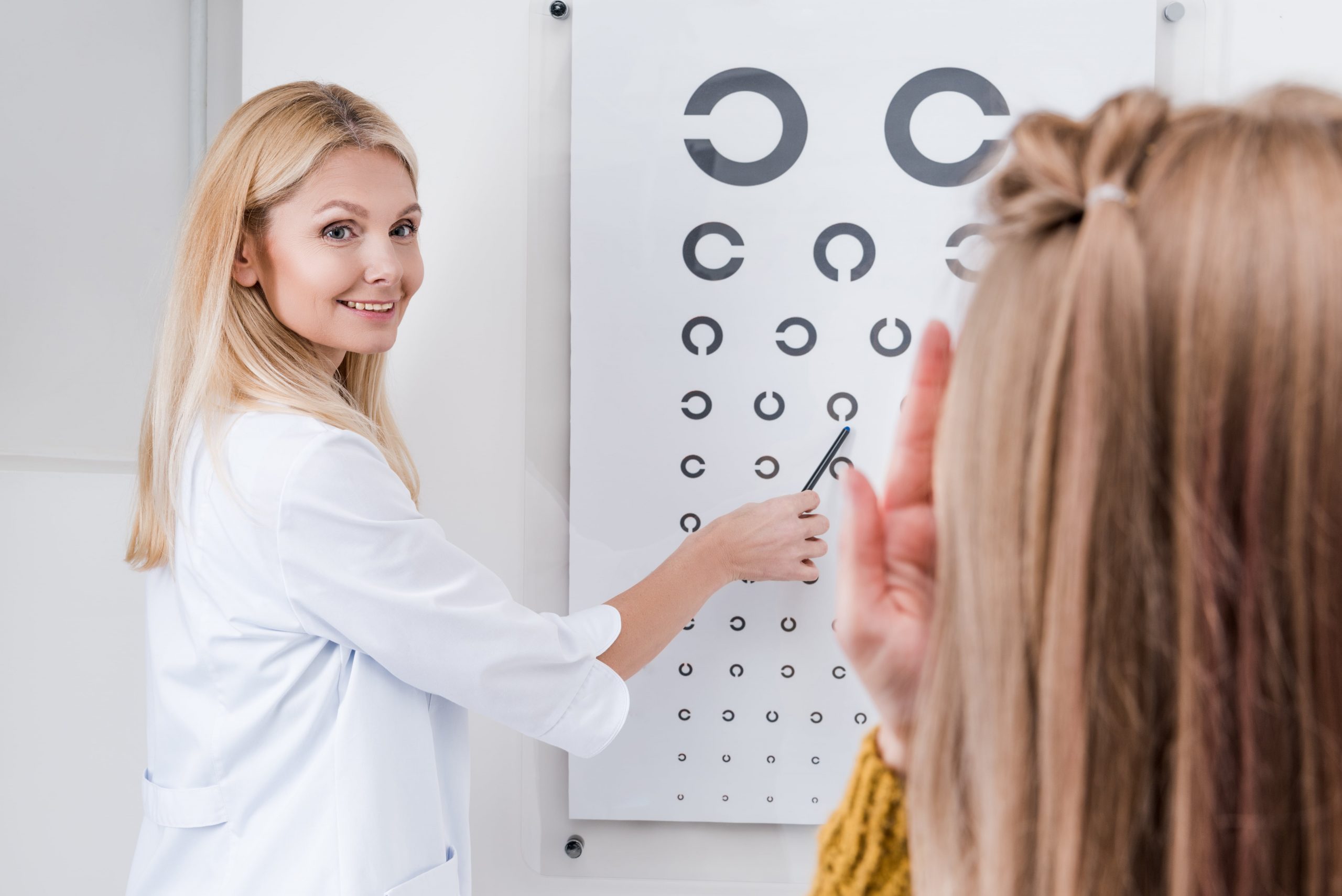Tunnel vision is a term used to describe a (peripheral vision loss)
Peripheral vision loss may be abrupt and frightening, or it might happen gradually without anybody noticing. Tripping, trouble walking in the dark, difficulties driving, seeing a curtain or spiderweb off to the side in your field of vision, and sparkles of light followed by tunnel vision lasting a few to twenty minutes are all indications of peripheral vision loss. It’s also possible that there aren’t any symptoms at all.
What is a peripheral vision?
Your central vision is made up of the items on which you concentrate your eyes (for example, the letters on an eye chart). Peripheral vision encompasses almost the whole remainder of your visual area.
It’s what enables you to view items all around you without having to move your head or your eyes. It assists you in detecting motion and walking without colliding with objects. When you notice anything “out of the corner of your eye,” this is what you’re referring to.
What is a field of view?
The area of the visible world that your eyes can perceive at any one time is known as your field of vision (or visual field).
Peripheral vision loss is a term that refers to a loss of eyesight on the side.
It’s usually a side consequence of another medical problem. Glaucoma and retinitis pigmentosa are two of the most frequent of these.
What is tunnel vision, and how does it work?
The term “tunnel vision” refers to a lack of peripheral vision. It may be caused by a number of factors and can be either transient or permanent.
Tunnel vision is a condition in which you can only see items directly in front of you due to a lack or loss of peripheral vision. By covering one eye and looking through the tube of a roll of toilet paper with the other, you may imitate severe tunnel vision.
Tunnel vision is a visual field defect in which all four parts of the visual field are constrained (reduced in size). To put it another way, your peripheral vision reduces in all directions (out, in, up, and down). The dark “tunnel” of your tunnel vision is the 360-degree loss of peripheral vision.
Tunnel vision usually develops over time, such as with glaucoma; but, depending on the source of the restricted visual field, tunnel vision may arise suddenly, such as with an ocular migraine.
Most occurrences of non-migraine tunnel vision and peripheral vision loss are, unfortunately, permanent and irreversible.
Symptoms of Peripheral Vision Loss
Migraines are more severe headaches that are typically accompanied by nausea or visual issues. Migraines may sometimes result in blurry vision in peripheral vision. Migraines, fortunately, only cause brief peripheral vision loss that should go away after the migraine is over.
It is typically easier to detect a problem with peripheral vision when it occurs suddenly; however, peripheral vision problems may develop slowly and signs of peripheral vision problems may be disregarded at first. Unfortunately, the longer tunnel vision problems are neglected, the more likely irreversible damage may occur. If you detect any issues with your peripheral vision, get medical attention right once.
A TIA or transient ischemic attack has stroke-like symptoms (including peripheral vision loss) and maybe an early warning sign of a possible stroke to come.
Peripheral vision loss (temporary)
There are several reasons, ranging from medical issues and mental stress to retinal strain. For temporary loss of peripheral vision, there are a few recognized causes, prevention measures, and therapies.
If you suffer from migraines, you may have had a migraine headache that was strong enough to induce peripheral vision loss in one eye, either before or after the headache.
Temporary peripheral vision loss is a common symptom of vasovagal syncope, a condition marked by a decrease in blood pressure that causes fainting. Pale skin, disorientation, and impaired vision are some of the other symptoms.
The condition is triggered by a stimulus, such as seeing blood, which causes your heart rate to drop and blood pressure to decrease, resulting in symptoms including peripheral vision loss and fainting. The Mayo Clinic recommends reclining down and elevating your feet to keep blood flowing if you feel dizzy or lose your peripheral vision.
Although emotional stress isn’t the cause of peripheral vision loss, fluctuations in blood pressure, such as a short drop during a highly emotional period, might cause dimming or loss of vision momentarily, according to the AAO.
What Makes You Lose It?
Peripheral vision loss may be caused by a variety of factors, ranging from minor difficulties to major disorders. Some may cause rapid and obvious peripheral vision difficulties, while others may induce more gradual alterations that, if left untreated, might ultimately lead to irreversible peripheral blindness.
Peripheral Vision Loss: The Most Common Causes
Glaucoma is a condition characterized by fluid and pressure accumulation in the eye. It has the potential to harm the nerve that transports information from the eye to the brain. Losing peripheral vision as a result of this. It’s possible that you’ll lose all of your vision over time. Fortunately, if your glaucoma is detected early enough, physicians can avoid visual loss.
Retinitis Pigmentosa (RP) is a hereditary illness that affects the retina, the light-sensing portion of the eye. One of the earliest signs is night blindness. You can also have trouble distinguishing between various hues. You’ll notice changes in your visual field over time. This illness may affect anybody at any age, although it is most common in teenagers and young adults. By the age of 40, the majority of those who have it are legally blind.
A detached retina is an uncommon but possible cause of peripheral vision loss. A detached retina is a significant medical disorder that may occur as a consequence of trauma, diabetes, or some other eye ailment. The retina must be repaired surgically, although the irreversible visual loss is possible.
Strokes are caused by a disruption in the blood flow to the brain and may cause a range of issues, including loss of peripheral vision. One-third of stroke survivors will have visual loss, and the majority will never completely regain their eyesight.
Peripheral vision loss may be a sign of a life-threatening disorder that should be investigated in an emergency room right away. If you or someone you’re with has any of these life-threatening symptoms, get medical help right once (call 911).
Confusion, delirium, lethargy, hallucinations, and delusions are examples of mental state or abrupt behavioral changes.
Diagnosing Issues with Peripheral Vision Tests
A visual field test will be performed by your doctor, who will position a bowl-shaped device that you put your face in. You’ll cover one eye with a patch so that each may be evaluated individually. Lights flash at various spots around the bowl as you stare straight ahead. When you see lights, you’ll click a button without rotating your head.
If you have an eye problem, your doctor may recommend that you take this test twice a year to monitor your vision changes. People who are at a greater risk of developing glaucoma should be examined on a frequent basis.
Treatment for a loss of peripheral vision
Though ordinary eyeglasses and contact lenses won’t assist with peripheral vision loss, low vision equipment like magnifiers and telescopic glasses may.
If you have some forms of peripheral vision loss, for example, special prism glasses may help you widen your side vision.
Consult a low vision specialist eye doctor to learn more about customized eyeglasses to deal with the loss of peripheral vision.
You won’t be able to regain your peripheral vision if you have glaucoma or RP. You may, however, be proactive and delay or halt the harm. If you do yoga, for example, avoid any poses that require you to be face down since this has been found to raise eye pressure.
If glaucoma is detected and treated early, your doctor may be able to prescribe drugs to lower the eye pressure that causes it. If it doesn’t work, surgery may be recommended.
Vitamin A has been shown in studies to help decrease the progression of RP-related visual loss. Your doctor can assist you in coping with bad vision and may be able to delay or stop the deterioration.
Most patients do not need therapy since the visual aspect of ocular migraine usually lasts less than an hour. Stop and take some time to rest your eyes until your eyesight returns to normal. Take an aspirin or Tylenol or other pain relievers that your doctor suggests if you have a headache.
Another gadget to consider is the sTMS small. At the first hint of a headache, you place it at the back of your head, and it emits a magnetic pulse that activates a region of the brain. Nerivio is an electrical neuromodulation device worn on the upper arm to relieve migraine headaches.
Drugs that treat epilepsy such as Topamax have been shown to help Migraines, along with tricyclic antidepressants (Elavil, etc), blood pressure meds (Metoprolol), and CGRP inhibitors like Vyepti.
What are the dangers of losing one’s peripheral vision?
Any permanent loss of vision may have a substantial impact on your quality of life as well as your mental health. Consider visiting a mental health expert for help on how to deal with this huge life transition if you have tunnel vision.
Be warned that losing your peripheral vision will impair your ability to drive safely. Even if you can see 20/20 on an eye chart, this may prohibit you from keeping, renewing, or obtaining a driver’s license.
Peripheral vision helps us to view the environment more clearly and be aware of activity outside of our center eyeline, therefore someone with weak peripheral vision might be in great danger.
Peripheral vision loss affects who?
Anyone may have peripheral vision loss, although older persons are more likely to have the underlying diseases that cause it. If you have peripheral vision loss, see your doctor right away to get a diagnosis and treatment for the underlying reason. The majority of patients with peripheral vision loss need continuing medical or eye treatment as a result of their disease.
Prevention
Prevention of peripheral vision loss is always the best course of action. If you need to lose weight, lose weight if you have high blood pressure eat better, and exercise. Permanent peripheral vision loss is almost always caused by an underlying cause. So take the steps you need to improve your overall health now before it becomes a problem. See your eye doctor and your regular physician regularly. If you already have permanent vision loss see a low vision specialist.














